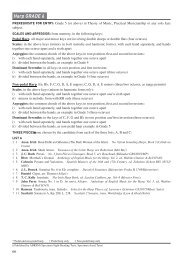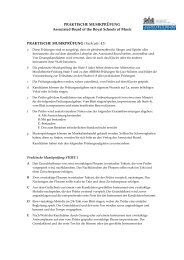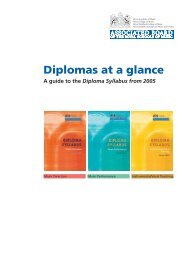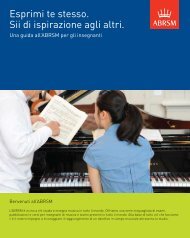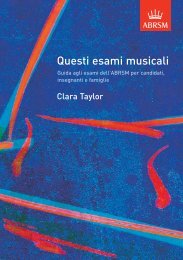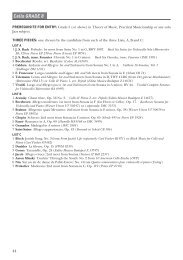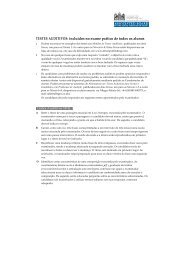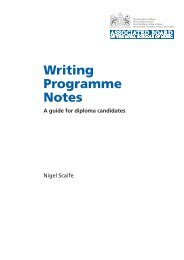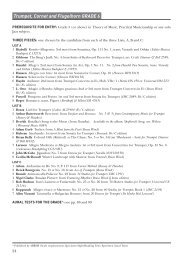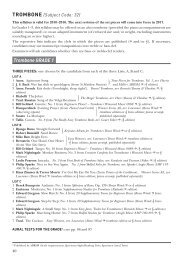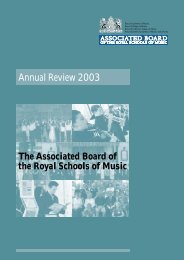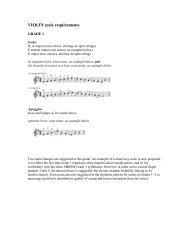LIBRETTO - ABRSM
LIBRETTO - ABRSM
LIBRETTO - ABRSM
You also want an ePaper? Increase the reach of your titles
YUMPU automatically turns print PDFs into web optimized ePapers that Google loves.
12<br />
POINT<br />
OF VIEW<br />
Staying connected –<br />
simultaneous learning for the advanced pupil<br />
Paul Harris<br />
I have received some very positive and<br />
encouraging feedback to my article,<br />
Simultaneous learning – teaching pupils to<br />
think musically, featured in Libretto 2001:3.<br />
This follow-up article applies the principles of<br />
simultaneous learning to more advanced<br />
teaching. The transition should be smooth and<br />
turbulence-free and if we have already begun to<br />
embrace a more holistic and imaginative<br />
approach to our teaching, it will be exciting and<br />
rewarding both for pupil and for teacher. But I<br />
am not re-inventing the wheel – the ideas,<br />
strategies and concepts are already very much<br />
the domain of many skilful, thoughtful and<br />
imaginative teachers. I am simply drawing these<br />
together in a more formalised manner and thus<br />
defining one approach to the teaching of our<br />
more advanced pupils.<br />
New areas of learning<br />
enter the arena<br />
I am sure we would all agree that the<br />
underlying direction of all good music teaching<br />
(from beginner onwards) is to broaden and<br />
deepen our pupil’s musical thinking and to<br />
develop their ability and confidence to make<br />
their own informed choices. Simultaneous<br />
learning, from the very first lesson, will certainly<br />
begin to achieve these ends. Of fundamental<br />
importance is always to make connections – as<br />
professional musicians, we do so instinctively and<br />
intuitively. Some of our pupils do too – and it is<br />
these who we soon label as the high-fliers. For<br />
the rest, our teaching should continually<br />
demonstrate how all the various strands of music<br />
learning are linked. As pupils progress, new areas<br />
of learning enter the arena and others develop<br />
and begin to play a more central and demanding<br />
role. So, in addition to further developing aural,<br />
key-sense, scales, technique, theory, rhythm,<br />
sight-reading, (and all their various relations!) we<br />
might now begin to see the gradual emergence<br />
of practical analysis, stylistic conventions,<br />
historical context, harmony and the need to<br />
Paul Harris is a teacher, composer, writer, clarinettist and<br />
examiner. The author of over 250 publications including<br />
The Music Teacher’s Companion – from <strong>ABRSM</strong> (Publishing)<br />
Ltd – and the Improve Your Sight-reading! series (Faber<br />
Music) and many works ranging from short educational<br />
pieces to five concertos and a ballet.<br />
develop a pupil’s ability to mould their own<br />
interpretation. You might like to repeat the<br />
exercise suggested in my previous article. Make a<br />
list of all the elements of music teaching – now<br />
including all the ‘new’ areas (both those I have<br />
suggested and any others that may occur to you)<br />
– and make two or three connections between<br />
each of them. This is how the mind enjoys<br />
working. As you teach, you will continually see<br />
more and more vistas opening up and<br />
increasingly more imaginative routes down<br />
which to steer your pupils.<br />
As our experience grows we soon begin to<br />
recognise, even among our very elementary<br />
pupils, those who will go on to take music<br />
seriously, passing through to the higher grades<br />
and perhaps on even further. Of course as<br />
teachers of integrity, we deliver the same quality<br />
of teaching to all our pupils, but human nature<br />
(together with a whole host of other reasons)<br />
will cause some pupils to shine – almost despite<br />
our efforts! These pupils will be more likely to go<br />
to concerts and actively listen to music. Also, as<br />
we begin to detect a real glimmer of enthusiasm,<br />
we should encourage them to build a collection<br />
of recordings of music they will eventually play.<br />
Such ‘broadening’ activities will bring about<br />
many advantages: pupils will begin to develop<br />
their own internal perception of the sound-world<br />
and potential of their instrument or voice; they<br />
will know that Bach, Mozart, Beethoven or<br />
Shostakovich piece prior to learning it – perhaps<br />
even for a number of years. It will have become<br />
part of their experience. ‘But they’ll play it just<br />
like Murray Perahia’ is a comment occasionally<br />
thrown back at me – my answer is simply, ‘if<br />
only!’ The sum total of their own musical<br />
experiences, the potential of their ear and<br />
technique, will of course produce a performance<br />
quite different from Perahia’s; but what they<br />
would have learnt, by knowing his interpretation<br />
will be considerable.<br />
Of course, we need to be able to learn music<br />
without any prior knowledge and we need to<br />
instil an approach that will ultimately generate<br />
successful study of unknown pieces. How might



